Abstract
A significant reduction of kallikrein activity in urine (assayed by its amidolytic activity) was found in 64 normotensive workers who had been exposed to cadmium for 11 years on average and whose cadmium concentrations in urine ranged from 2.2 to 33.1 micrograms/g creatinine. The mean (geometric) urinary kallikrein activity (in U/g creatinine) amounted to 0.52 (range 0.11-1.90) in the control group (n = 193) against 0.39 (range 0.10-1.03) in the cadmium group, and the prevalence of abnormally low activity levels (less than or equal to 0.20 U/g creatinine) amounted to 17.2% in the cadmium group against 5.2% in the control group. A reduction of aldosterone release (aldosterone in urine) associated with an increased natriuresis was also observed. This might constitute a compensatory mechanism maintaining blood pressure in the normal range. These biological effects of cadmium were not reversible after removal from exposure. This study indicates that cadmium can induce an irreversible toxic effect in the distal nephron. It also suggests that an excessive cadmium body burden alone may not be sufficient to induce hypertension, but in individuals whose blood pressure regulation may be impaired by other factors cadmium could stimulate the development of hypertension. This study also supports the recommendation to prevent hypertensive subjects from being exposed to cadmium. There was no indication that moderate exposure to mercury vapour (n = 53; mercury in urine, range 11-224 micrograms/g creatinine; average duration of exposure: six years) or to inorganic lead (n = 23; lead in blood, range 40-67 micrograms/100 ml; average duration of exposure: eight years) was associated with a reduction of kallikrein production by the kidney.
Full text
PDF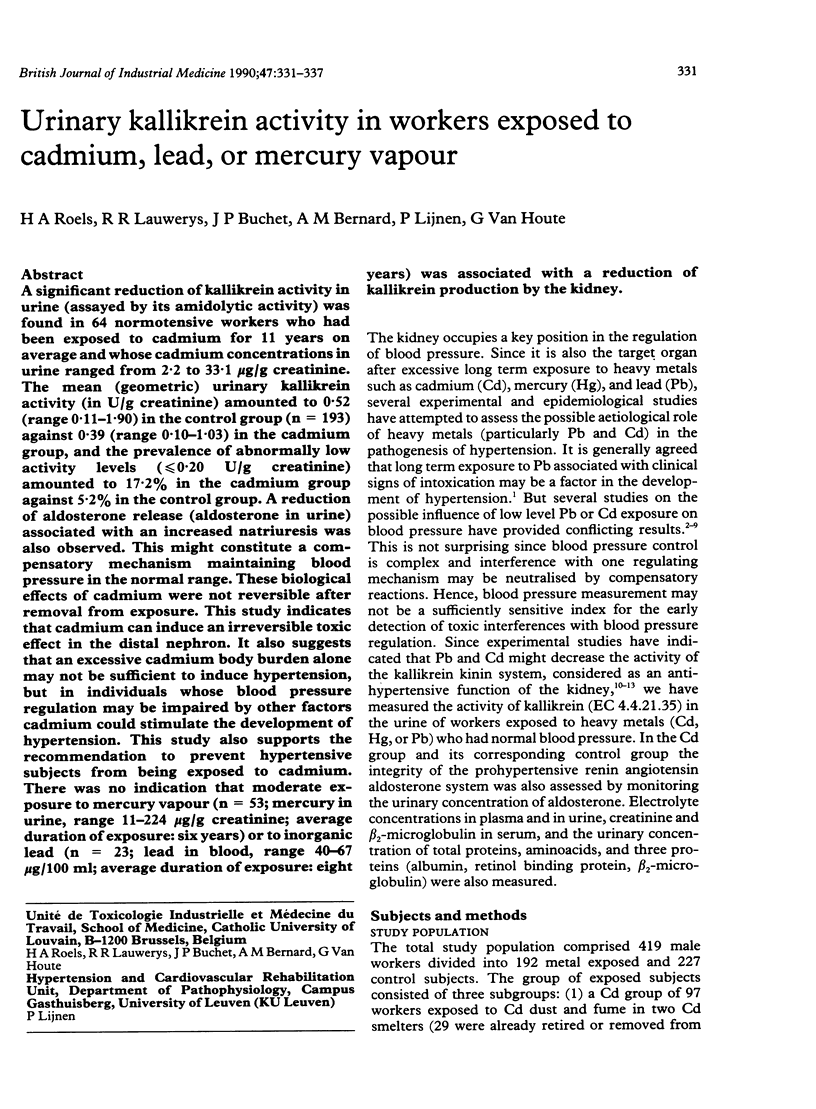
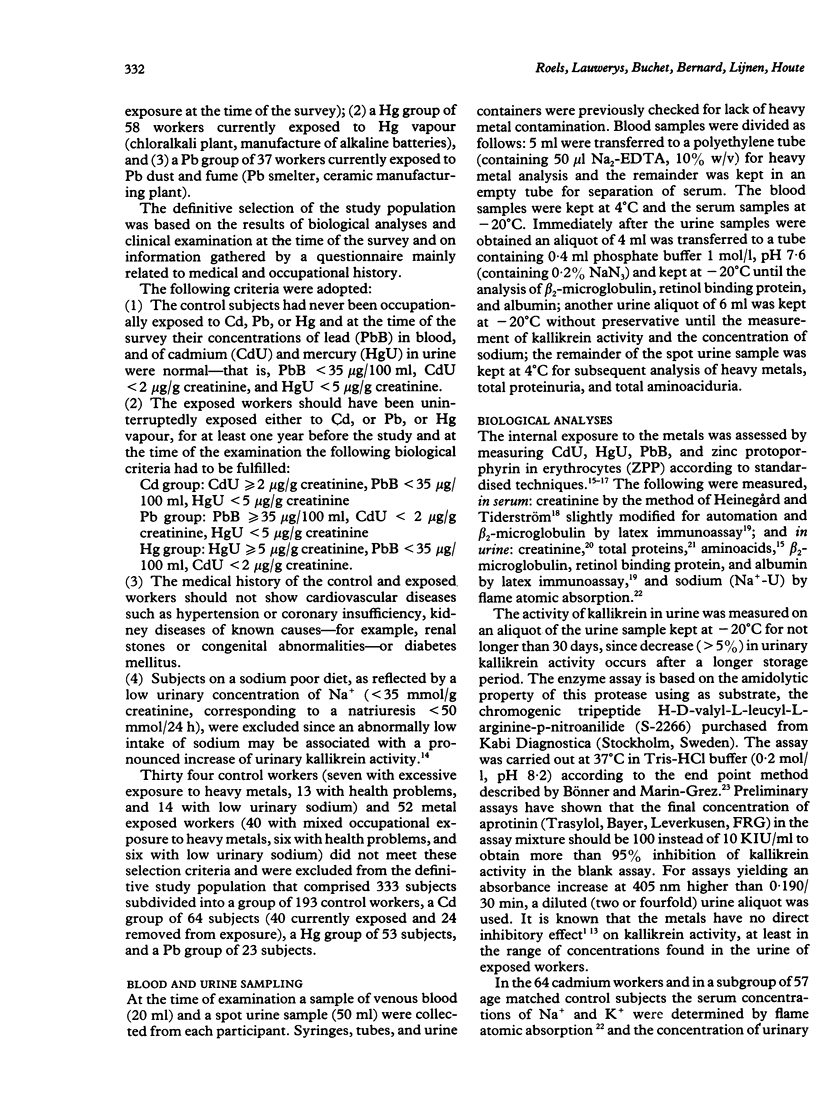
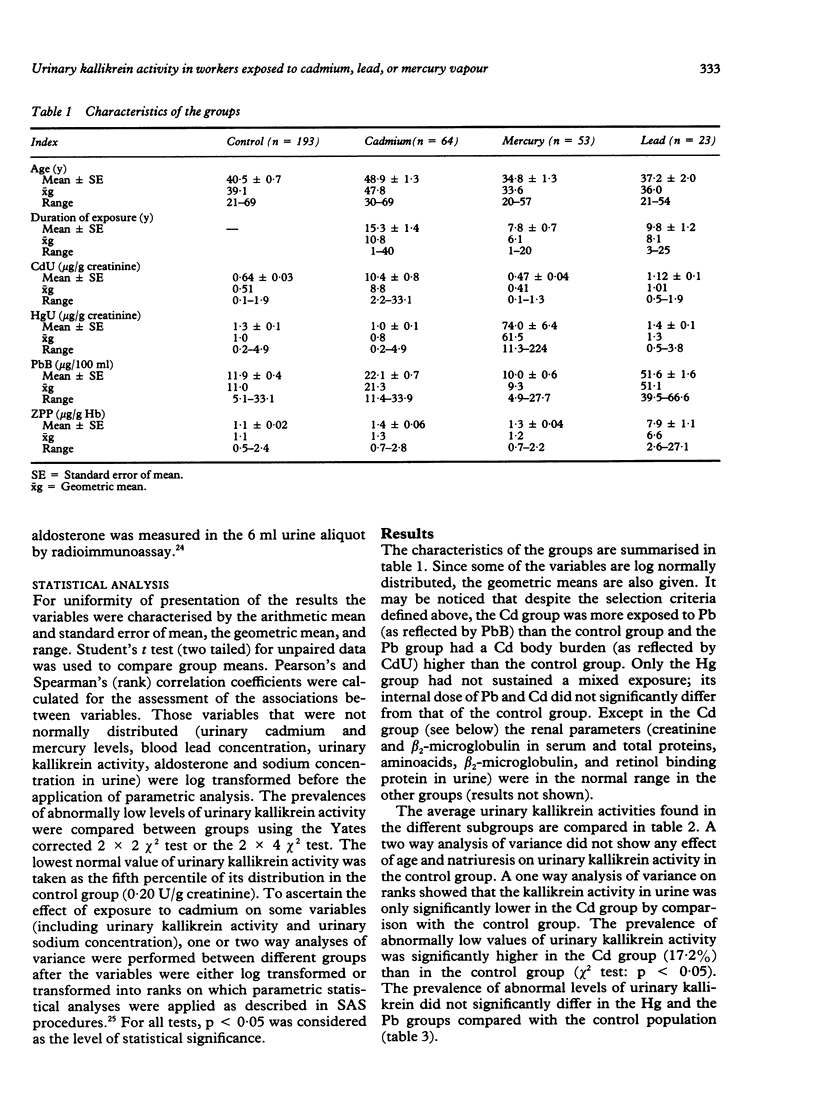
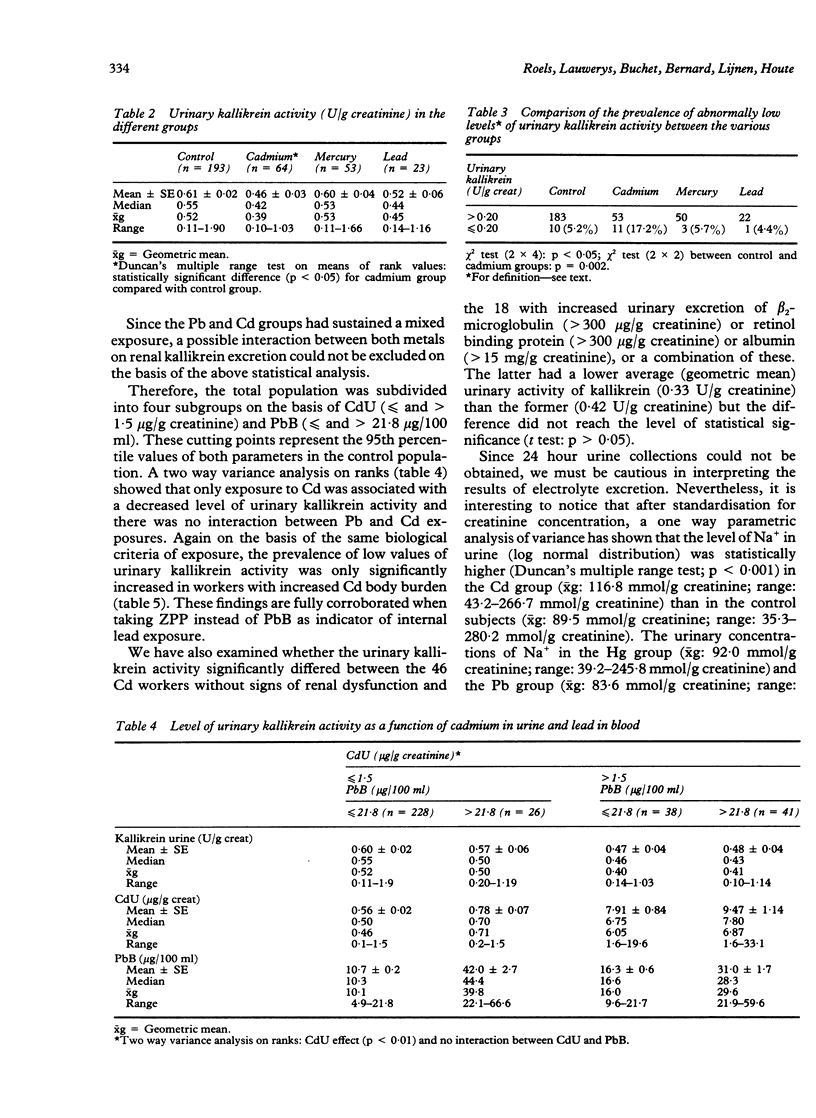
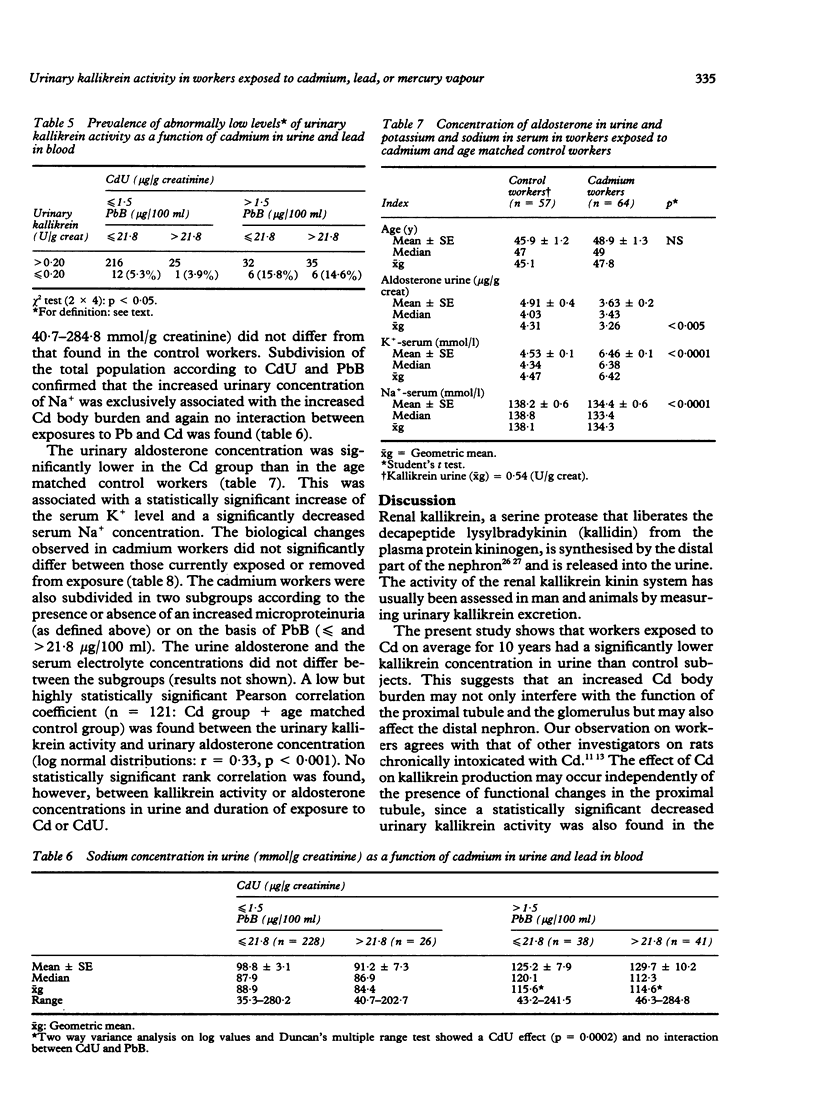
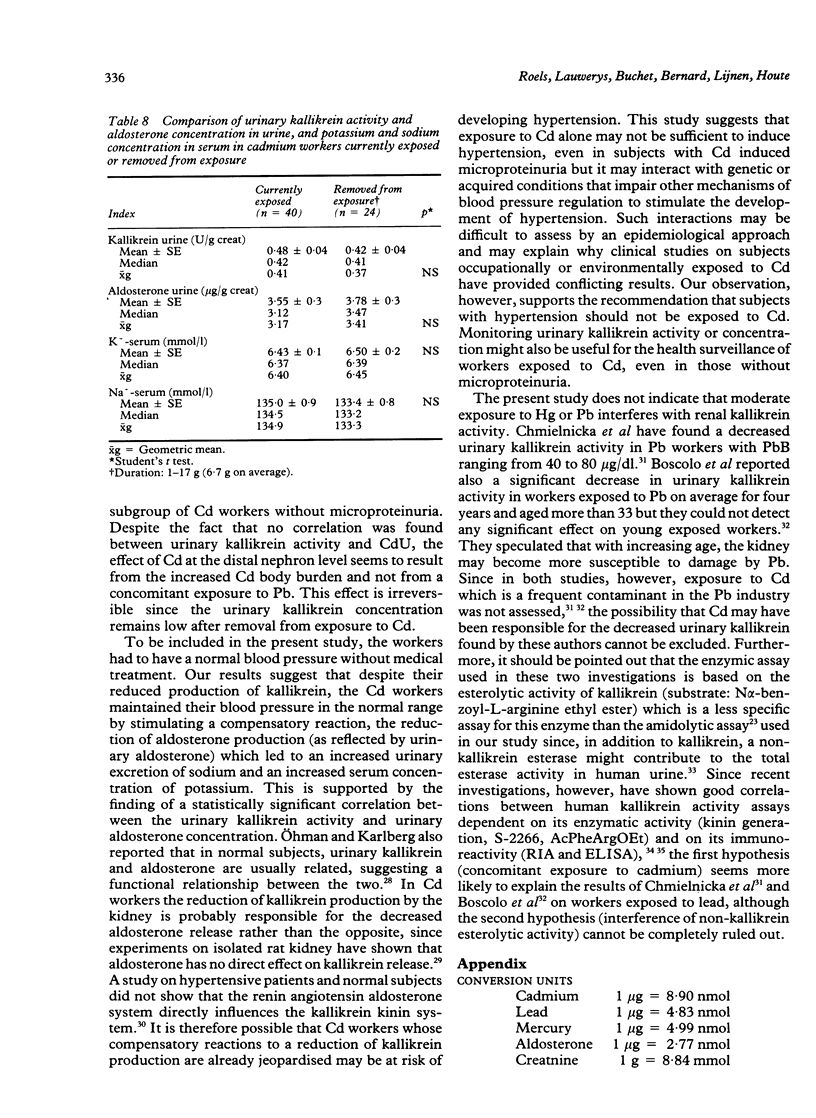
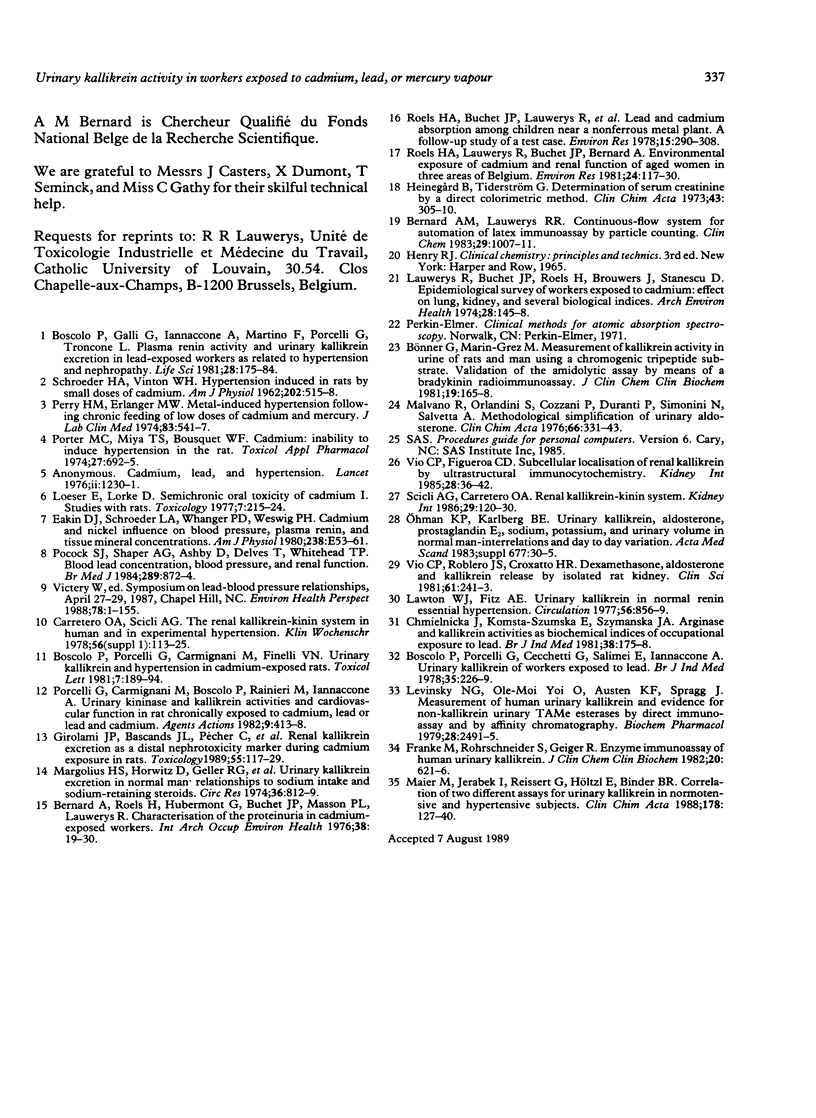
Selected References
These references are in PubMed. This may not be the complete list of references from this article.
- Bernard A. M., Lauwerys R. R. Continuous-flow system for automation of latex immunoassay by particle counting. Clin Chem. 1983 Jun;29(6):1007–1011. [PubMed] [Google Scholar]
- Bernard A., Roels H., Hubermont G., Buchet J. P., Masson P. L., Lauwerys R. R. Characterization of the proteinuria in cadmium-exposed workers. Int Arch Occup Environ Health. 1976 Oct 21;38(1):19–30. doi: 10.1007/BF00378317. [DOI] [PubMed] [Google Scholar]
- Boscolo P., Galli G., Iannaccone A., Martino F., Porcelli G., Troncone L. Plasma renin activity and urinary kallikrein excretion in lead-exposed workers as related to hypertension and nephropathy. Life Sci. 1981 Jan 12;28(2):175–184. doi: 10.1016/0024-3205(81)90550-6. [DOI] [PubMed] [Google Scholar]
- Boscolo P., Porcelli G., Carmignani M., Finelli V. N. Urinary kallikrein and hypertension in cadmium-exposed rats. Toxicol Lett. 1981 Jan;7(3):189–194. doi: 10.1016/0378-4274(81)90066-7. [DOI] [PubMed] [Google Scholar]
- Boscolo P., Porcelli G., Cecchetti G., Salimei E., Iannaccone A. Urinary kallikrein activity of workers exposed to lead. Br J Ind Med. 1978 Aug;35(3):226–229. doi: 10.1136/oem.35.3.226. [DOI] [PMC free article] [PubMed] [Google Scholar]
- Bönner G., Marin-Grez M. Measurement of kallikrein activity in urine of rats and man using a chromogenic tripeptide substrate. Validation of the amidolytic assay by means of bradykinin radioimmunoassay. J Clin Chem Clin Biochem. 1981 Mar;19(3):165–168. doi: 10.1515/cclm.1981.19.3.165. [DOI] [PubMed] [Google Scholar]
- Chmielnicka J., Komsta-Szumska E., Szymańska J. A. Arginase and kallikrein activities as biochemical indices of occupational exposure to lead. Br J Ind Med. 1981 May;38(2):175–178. doi: 10.1136/oem.38.2.175. [DOI] [PMC free article] [PubMed] [Google Scholar]
- Eakin D. J., Schroeder L. A., Whanger P. D., Weswig P. H. Cadmium and nickel influence on blood pressure, plasma renin, and tissue mineral concentrations. Am J Physiol. 1980 Jan;238(1):E53–E61. doi: 10.1152/ajpendo.1980.238.1.E53. [DOI] [PubMed] [Google Scholar]
- Franke M., Rohrschneider S., Geiger R. Enzyme immunoassay of human urinary kallikrein. Determination of human urinary kallikrein, III. J Clin Chem Clin Biochem. 1982 Sep;20(9):621–626. doi: 10.1515/cclm.1982.20.9.621. [DOI] [PubMed] [Google Scholar]
- Heinegård D., Tiderström G. Determination of serum creatinine by a direct colorimetric method. Clin Chim Acta. 1973 Feb 12;43(3):305–310. doi: 10.1016/0009-8981(73)90466-x. [DOI] [PubMed] [Google Scholar]
- Lauwerys R. R., Buchet J. P., Roels H. A., Brouwers J., Stanescu D. Epidemiological survey of workers exposed to cadmium. Arch Environ Health. 1974 Mar;28(3):145–148. doi: 10.1080/00039896.1974.10666455. [DOI] [PubMed] [Google Scholar]
- Lawton W. J., Fitz A. E. Urinary kallikrein in normal renin essential hypertension. Circulation. 1977 Nov;56(5):856–859. doi: 10.1161/01.cir.56.5.856. [DOI] [PubMed] [Google Scholar]
- Levinsky N. G., ole-MoiYoi O. K., Austen K. F., Spragg J. Measurement of human urinary kallikrein and evidence for non-kallikrein urinary TAMe esterases by direct immunoassay and by affinity chromatography. Biochem Pharmacol. 1979 Aug 15;28(16):2491–2495. doi: 10.1016/0006-2952(79)90013-3. [DOI] [PubMed] [Google Scholar]
- Loeser E., Lorke D. Semichronic oral toxicity of cadmium. I. Studies on rats. Toxicology. 1977 Apr;7(2):215–224. doi: 10.1016/0300-483x(77)90067-1. [DOI] [PubMed] [Google Scholar]
- Maier M., Jerabek I., Reissert G., Höltzl E., Binder B. R. Correlation of two different assays for urinary kallikrein in normotensive and hypertensive subjects. Clin Chim Acta. 1988 Dec 15;178(2):127–139. doi: 10.1016/0009-8981(88)90219-7. [DOI] [PubMed] [Google Scholar]
- Malvano R., Orlandini S., Cozzani P., Duranti P., Simonini N., Salvetti A. Methodological simplifications in radioimmunoassay of urinary aldosterone. Clin Chim Acta. 1976 Feb 2;66(3):331–343. doi: 10.1016/0009-8981(76)90232-1. [DOI] [PubMed] [Google Scholar]
- Perry H. M., Jr, Erlanger M. W. Metal-induced hypertension following chronic feeding of low doses of cadmium and mercury. J Lab Clin Med. 1974 Apr;83(4):541–547. [PubMed] [Google Scholar]
- Pocock S. J., Shaper A. G., Ashby D., Delves T., Whitehead T. P. Blood lead concentration, blood pressure, and renal function. Br Med J (Clin Res Ed) 1984 Oct 6;289(6449):872–874. doi: 10.1136/bmj.289.6449.872. [DOI] [PMC free article] [PubMed] [Google Scholar]
- Porter M. C., Miya T. S., Bousquet W. F. Cadmium: inability to induce hypertension in the rat. Toxicol Appl Pharmacol. 1974 Mar;27(3):692–695. doi: 10.1016/0041-008x(74)90049-0. [DOI] [PubMed] [Google Scholar]
- Roels H. A., Buchet J. P., Lauwerys R., Bruaux P., Claeys-Thoreau F., Lafontaine A., van Overschelde J., Verduyn G. Lead and cadmium absorption among children near a nonferrous metal plant: a follow-up study of a test case. Environ Res. 1978 Apr;15(2):290–308. doi: 10.1016/0013-9351(78)90105-6. [DOI] [PubMed] [Google Scholar]
- Roels H. A., Lauwerys R. R., Buchet J. P., Bernard A. Environmental exposure to cadmium and renal function of aged women in three areas of Belgium. Environ Res. 1981 Feb;24(1):117–130. doi: 10.1016/0013-9351(81)90138-9. [DOI] [PubMed] [Google Scholar]
- SCHROEDER H. A., VINTON W. H., Jr Hypertension induced in rats by small doses of cadmium. Am J Physiol. 1962 Mar;202:515–518. doi: 10.1152/ajplegacy.1962.202.3.515. [DOI] [PubMed] [Google Scholar]
- Scicli A. G., Carretero O. A. Renal kallikrein-kinin system. Kidney Int. 1986 Jan;29(1):120–130. doi: 10.1038/ki.1986.14. [DOI] [PubMed] [Google Scholar]
- Victery W., Tyroler H. A., Volpe R., Grant L. D. Summary of discussion sessions: symposium on lead-blood pressure relationships. Environ Health Perspect. 1988 Jun;78:139–155. doi: 10.1289/ehp.8878139. [DOI] [PMC free article] [PubMed] [Google Scholar]
- Vío C. P., Figueroa C. D. Subcellular localization of renal kallikrein by ultrastructural immunocytochemistry. Kidney Int. 1985 Jul;28(1):36–42. doi: 10.1038/ki.1985.115. [DOI] [PubMed] [Google Scholar]


